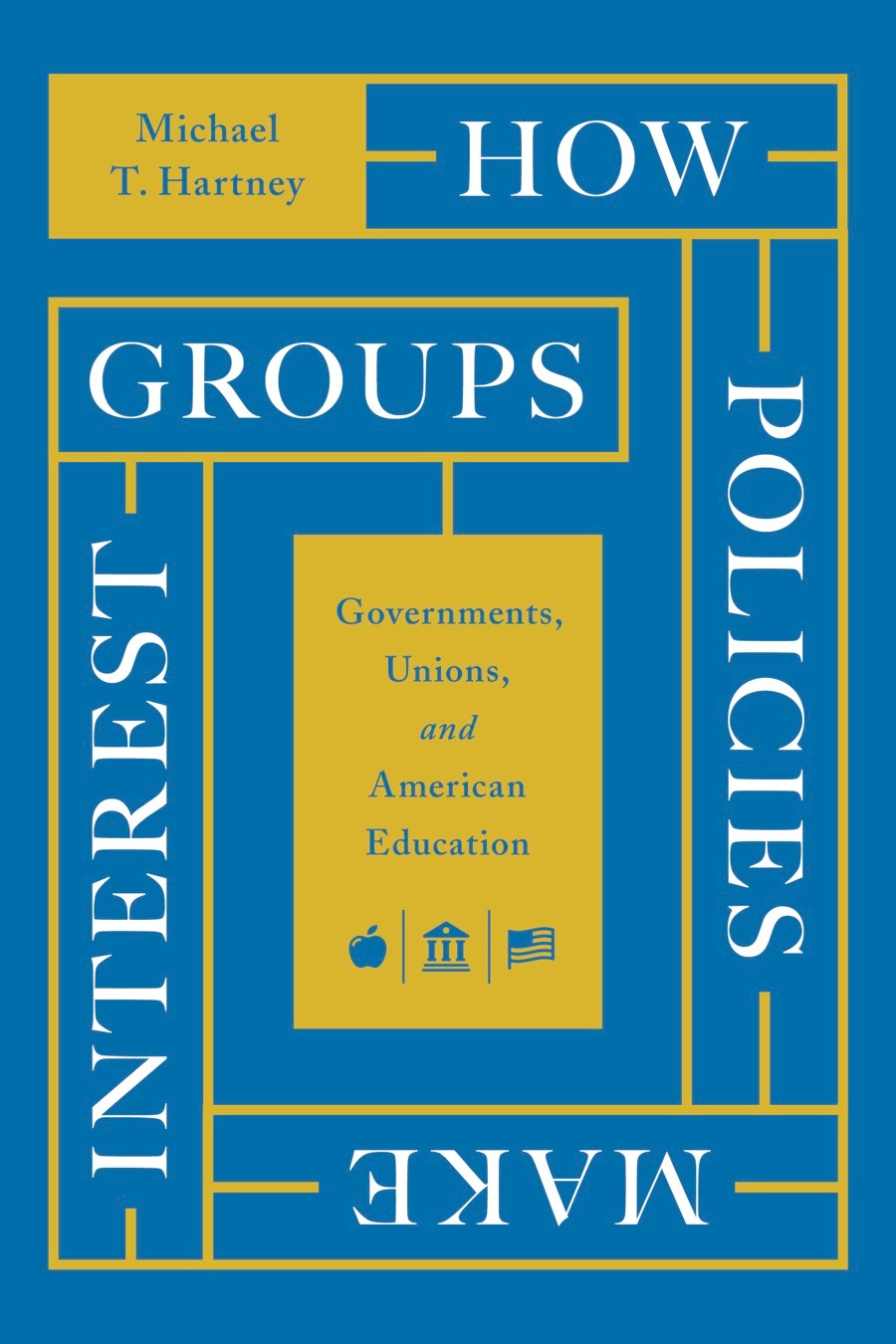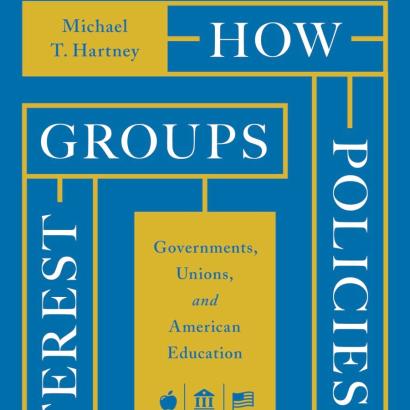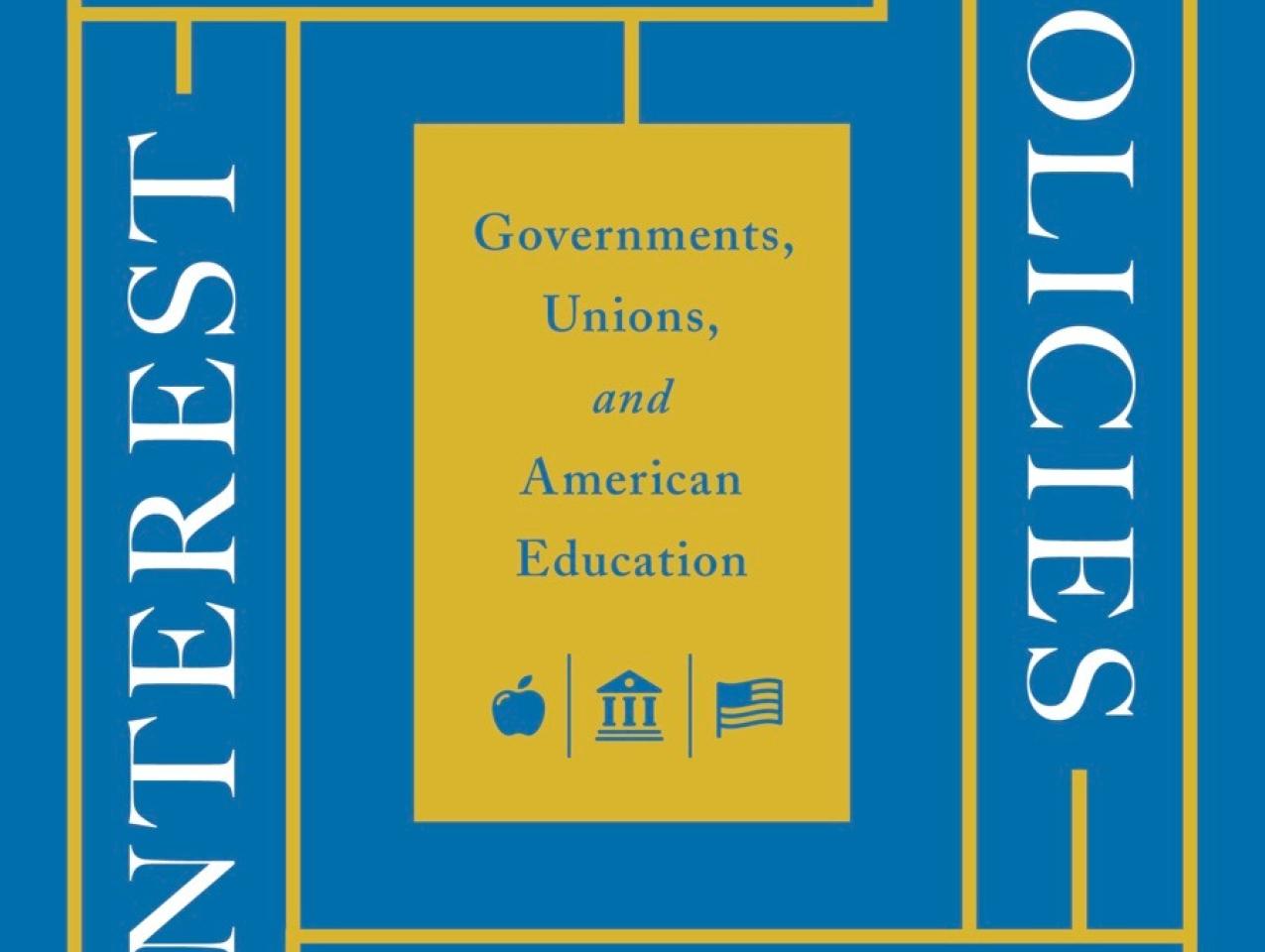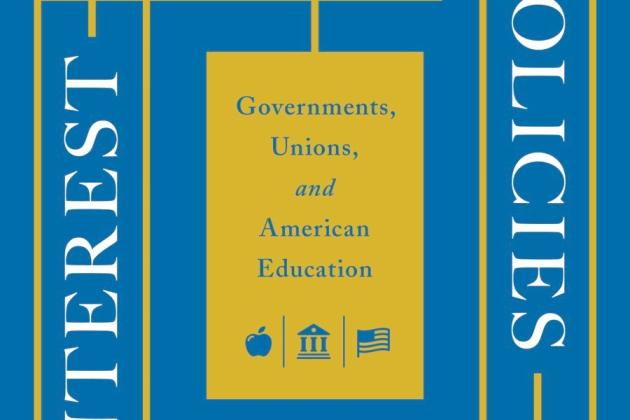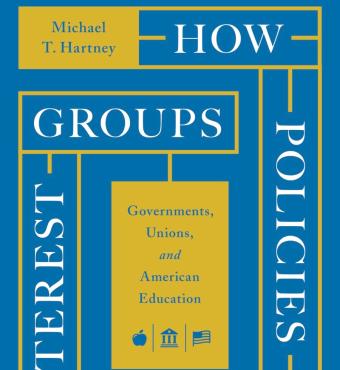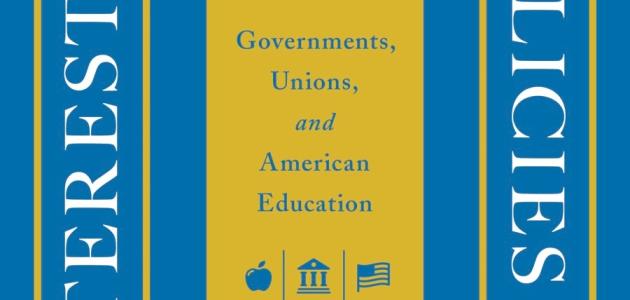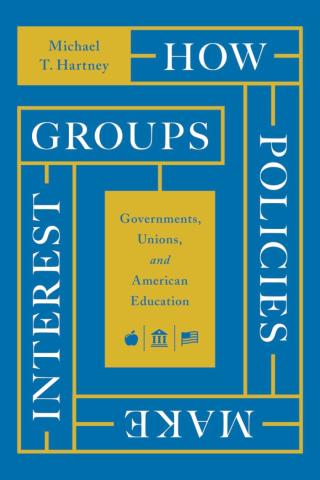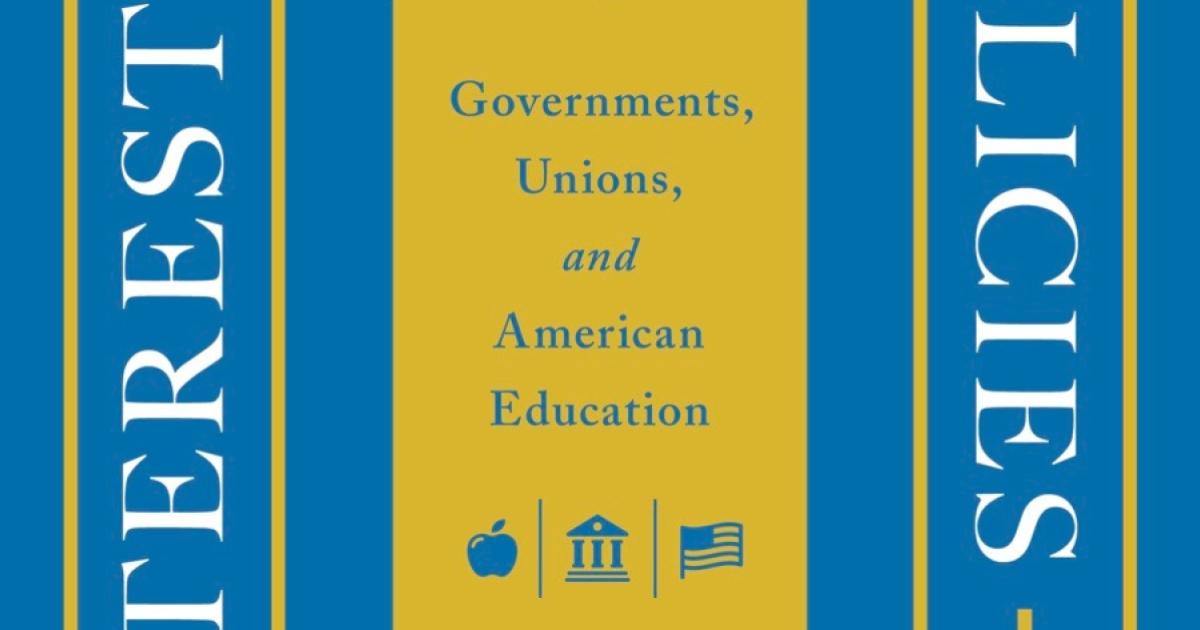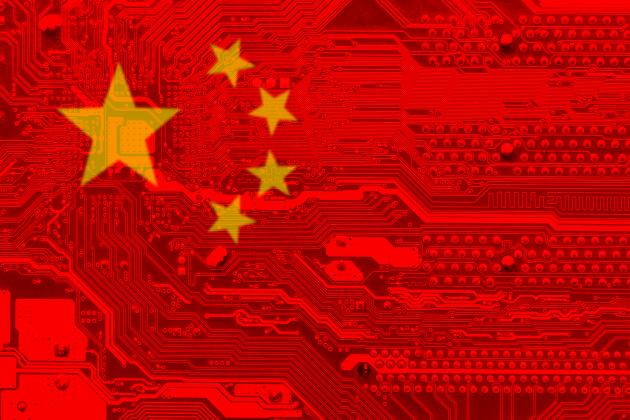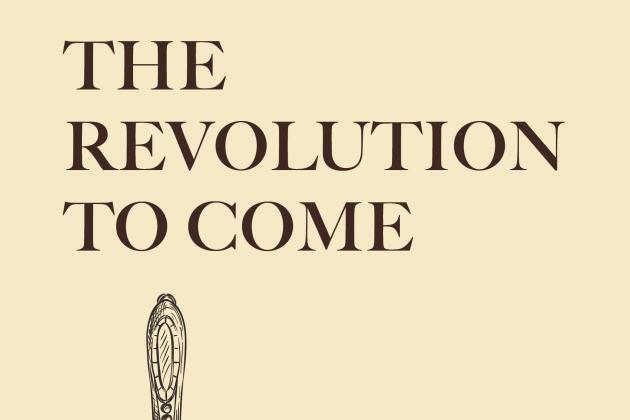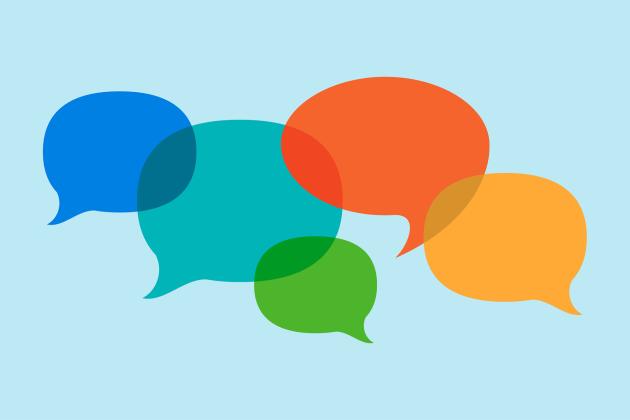Join the Hoover Book Club for engaging discussions with leading authors on the hottest policy issues of the day. Hoover scholars explore the latest books that delve into some of the most vexing policy issues facing the United States and the world. Find out what makes these authors tick and how they think we should approach our most difficult challenges.
In our latest installment, watch a discussion between Senior Fellow Terry Moe and Hoover Fellow Michael Hartney, author of How Policies Make Interest Groups: Governments, Unions, and American Education on Tuesday, February 14, 2023 at 10:00 am PT / 1:00pm ET.
WATCH HERE
>> Terry Moe: Hello, I'm Terry Moe, a senior fellow at the Hoover Institution and a professor of political science at Stanford University. Welcome to our latest installment of the Hoover Book Club, where we bring Hoover fellows and friends together to discuss their latest writings. Today, we're joined by Hoover fellow Michael Hartney, who has written a new book.
The title is how policies make interest groups. The subtitle is governments, unions, and American education. Hi, Michael, welcome.
>> Michael Hartney: Thank you, good to be here.
>> Terry Moe: Yeah, great to see you. I look forward to our discussion today. So just to kick this thing off, your book is very much about the teachers unions, about their rise to power and the various roles they've played in American education.
So how did this project come about? Why did you choose to study the teachers unions?
>> Michael Hartney: Yeah, there's actually quite an interesting story behind that. This is almost a book that really never came to fruition for two reasons. One, a lot of mentors and other senior scholars in the field told me when I was a young graduate student, if you write on teachers unions and you say anything that's not laudatory or your research comes down in some ways that teachers unions might not like, it will be career suicide.
So there were some voices saying, you weren't one of them, you were one of the sort of rays of light out there. But most people said, this is a political minefield, you don't wanna touch it. The second reason was that there's not a lot of data out there.
Most of the best data is held by the unions themselves. And so very early in the project, I actually reached out to the director of research at one of the nation's two largest teachers unions and asked if they would furnish me with some basic information on the candidates that they had endorsed for the school board in a particular state.
And I guess this particular person did an Internet search on me and came across a paper that I published in a scholarly journal. And what's interesting is that the paper I published showed quite clearly that in states where this teacher's union was politically active, the union was very effective in blocking the policies that it opposed.
And I was sort of, I found it kind of humorous when this person told me, we're not gonna share data with you because we didn't like that article, because in my mind, as a political scientist who studies interest groups, what I had just shown was that this gentleman's interest group was very effective.
But for whatever reason, it's not easy to get data in this area. And so for those two reasons, I almost didn't tackle it, I'm glad I persisted. And I know we're gonna talk about some of sort of how I did that and what went into that today.
>> Terry Moe: And so would you say that the teachers unions are central to what happens in American education?
>> Michael Hartney: You can't divorce, particularly since 1983. And those of us who study education politics kind of look at 1983 as this pivot point in the history of American education, the rise of the performance based era of reform, where we sort of looked at schools and we said, they need to be doing a lot better academically.
You can't understand those efforts to reform American education without putting the teachers unions at the center of your arguments, at the center of your analysis. And other than a book that you wrote, I think, 2011, that came out really, there was no scholarship among political scientists, at least not book length treatments on this topic.
So it's unfortunate. And it's also true, I should say, that there's really not much written with a political lens, sort of an interest group focus, a policy influence story in schools of education either. I mean, there's some rare exceptions, but it's few and far between.
>> Terry Moe: So how did the teachers unions become so important to what happens in education and to the politics of education?
Where did this all come from? How far back does it go? What were they like back around the turn of the century and later on up to the present day?
>> Michael Hartney: Yeah, well, one of the most interesting things that sort of, when I knew that there was a story to be told here that really happened when I, I made several trips to the NEA's archives in Washington, DC, there at George Washington University, and I came across a very old publication.
It was an internal survey that the NEA, just for folks listening, the NEA is the nation's largest teachers union. It clicks in at about 3 million members, give or take the year. You're looking at the largest labor union in all of North America. And so I'm in the archives and I come across a survey that the NEA did of its members in the 1950s.
And the survey revealed that teachers thought that outside of voting in, say, presidential year elections, that political activity was something that teachers shouldn't do. I mean, this was remarkable when we all know today that teachers unions and teachers are some of the most likely folks to vote in school board elections.
The unions are very active in making endorsements in those elections and quite effective. We'll talk a little bit about that, I'm sure. But you go back 50 years, and the NEA's big problem was that 75% of their members thought it was even inappropriate for teachers to talk to their colleagues about which school board members teachers should support.
So right off the bat, I said, there's a huge puzzle here. And so I asked the question in the first half of the book, how did that all come to change? And so the answer, in brief, and we can drill down a bit on this, but the answer, in brief, is government.
Government intervened, and in particular, state governments in the 1960s and 1970s when they adopted public sector labor laws that empowered public employees, not only teachers, of course, but teachers were the largest group, public employees to collectively bargain with state and local governments. And my book argues that that was a defining point that really ushered in the sea change where unions were able to mobilize teachers in politics and unions were able to build a large war chest of political money to spend and the like.
>> Terry Moe: Okay, so let's go back a bit. If you go back to the early 19 hundreds and working up through that period, if you look across the world, teachers unions had emerged and were powerful and very active in other countries, in other western nations, western democratic nations. What were they like here back then?
>> Michael Hartney: Well, I can report, I mean, my focus was less, say, on the collective bargaining process in looking at this and more on how they were perceived by lawmakers. And in my research, the quotations that I came across, the surveys of state legislatures prior to the 1960s, there's that period, 1940, 1950, is that two points?
One, teachers were considered to have very little influence over education policy making. And two, state legislators did not deem them a particularly influential voice in American politics either. So they were neither perceived. As powerful in education, nor were they perceived as active and influential in politics. And so the result of that is something that was of concern to the teachers unions.
But you have to remember that at this time period before the 1960s, these associations that existed, and they referred to themselves more as associations than unions, certainly in the case of the NEA. They really represented the interests of school administrators, superintendents, sort of leadership, very male dominated leadership ranks, and the education workforce, which was, of course, overwhelmingly female.
To the extent that these organizations did much for them, it was really only as an indirect byproduct of the NEA, say, lobbying for more educational funding from the federal or state governments. Obviously, there wasn't a lot of federal funding, but that's something that the association would do. But in terms of representing the occupational interests of teachers, that wasn't something that happened until after the advent of collective bargaining in the 1960s.
>> Terry Moe: Yeah, so, I mean, I think it's an interesting thing that public and private sector unions have very different histories in this country. I mean, the private sector unions had the National Labor Relations Act in 1935 that really gave a huge boost to private sector unions. By 1953 or so, a third of private sector members or private sector workers were union members.
So what was going on in the public sector then? The teachers unions are part of the public sector, not part of the private sector. They weren't covered by the National Labor Relations act. So what was happening in the public sector? Why weren't public sector unions included? Why weren't they getting organized?
>> Michael Hartney: Well, you have to start with the sort of prevailing ethos that existed, right? I mean, as many of those watching probably know, Franklin Roosevelt himself was very skeptical of the idea that you could transplant traditional industrial style collective bargaining to the public sector. And the reasons, I mean, we're manifold, but quite obvious that when it comes to government, the government is supposed to be representing and watching out for the taxpayers.
It's supposed to be getting the best quality public service that it can get at the lowest possible cost. And so that kind of ran anathema to the idea that we ought to empower, and particularly empower public sector workers with the right to withhold their services or what we would call strikes.
That this was a problem, would be a problem for public safety if you expanded the right to bargain, to, say, police or fire, and it would expand to the problem of teachers if you wanted them to be in the classroom and not out on the picket line. So there was just a prevailing ethos against it, and as a result, because teachers and other public sector workers were left out, and the story gets more complicated.
Of course, there have been efforts over time to pass a nationwide public sector collective bargaining law. Those were defeated. Sometimes it was because the signals being sent by the Supreme Court were that they would not allow that, because it would take away the rights of states to define their relationships with their own workforces.
So there's some other idiosyncratic reasons, but the bottom line is teachers unions were not able to get organized and get involved in collective bargaining until state governments of their own volition decided to enact laws that were analogous to that 1935 National Labor Relations act. And then when they did, that's when we see a flurry of teacher union organizing and activity across the states in the 1960s and 1970s.
>> Terry Moe: Okay, so public sector workers, in terms of unionization, were sort of late to the party, right? I mean, in the private sector, a lot of workers were unionized starting in the late. Actually, they began to get unionized before the National Labor Relations Act, but afterwards, there was a big increase in unionization, but not among public sector workers.
So when was it that the states, many of them, started to adopt these labor laws that gave public sector workers, including teachers, the same kinds of rights that private sector workers had?
>> Michael Hartney: So Wisconsin in 1959, became the first state to enact a mandatory public sector collective bargaining law.
And I think it's also important to just briefly mention what that is, by the way. So when a state adopts a mandatory collective bargaining law for public employees, what it means in practice is that once it varies from state to state the details of their law. But for the most part, it means that when a majority of employees in a given bargaining unit, so if we're using teachers as an example, the majority of teachers in a school district vote that they want to be represented by a union.
That at that point, under that mandatory bargaining law, the local school district government has to legally sit down and bargain over salary, wages, and working conditions with the union. And then there's a whole set of regulatory laws and rules, oftentimes governed by a public sector employee relations board, that maps out what that looks like.
But it's a real game changer for the responsibilities that the school board itself, as the representative of the public, owes to the teacher union employees. But to return to your question, so 1959, Wisconsin's the first state to adopt such a law. And then we see a lot more of it in the mid sixties, but particularly in the seventies.
And when the smoke clears by 1990, I believe it's about 34 states. Certainly the majority of teachers in the United States were covered or working in a state with a public sector collective bargaining law by 1980. And then New Mexico, I think, is the last one to add one in 1992.
So it was a real sea change that happened in a pretty quick period of time. And I think it's important as well to mention that the period of time in which it happened, the timing and sequence is very important. Because going back to what I mentioned at the outset, to your first question, a nation at risk, the movement to reform America's schools, to try things like new accountability mechanisms, charter schooling, all the things that are the talk of reformers today that doesn't get started until the mid eighties.
And so the teachers unions were able to get a head start and sort of get their power built up through collective bargaining and through political activism, well ahead of the reformers. And that's really had large ramifications for the battle between teachers' unions and reformers over American education policy.
>> Terry Moe: So did teachers get unionized only in states that had collective bargaining law legislation, or did states that didn't have that kind of legislation, like Alabama and Texas? Did teachers unionize there, too, and become powerful?
>> Michael Hartney: So in regard to, there were only a handful of states, really, that outright made collective bargaining illegal, explicitly illegal.
And I think that probably that number vacillated between maybe four to seven states, give or take the particular year. Those states that weren't in the 34 I had talked about that adopted those mandatory Bargaining laws kind of fell into what was classified as permissive states. So if the school board wanted to bargain and agree on a contract, they could.
And in fact, in many cases, we did see that happen. Colorado is a state that comes to mind that over the years, some of its larger school districts bargained collectively with teachers, even without that mandatory public sector collective bargaining law. But there's something else in your question which is really important, and that is that it's a myth.
A lot of people think it's the case, but it's a myth that teachers unions, or if you, some people will push back, you can't call it a union if it doesn't bargain collectively. Okay, fine. Teacher interest groups or teacher association interest groups, they're pretty powerful in almost every state.
Now, that varies, I wouldn't claim that teachers unions in Alabama historically were necessarily as powerful as maybe in California, but they were also pretty powerful. And the reason for that is manifold. But it relates to the fact that, first off, as employees, they have a perpetual, never ending incentive to monitor what's going on in education policy.
We look at the percentage of people that turn out to vote in school board elections or will show up to a school board meeting when there's a controversial issue on the agenda. And it's not a big number, so just a little bit of activism can go a long way.
And obviously, teachers and other public school employees have an incentive that other citizens don't. But another reason is that states like Alabama, for example, the interesting case, the union there became quite powerful even without collective bargaining. And they were able to do that because the state legislature, which was controlled then by Democrats in a very clever sort of way, if you will, decided that it wanted to help out its political ally in the state's teachers union, the Alabama Education association.
So in 1983, the legislature adopted a law that required local school district governments in Alabama to automatically deduct the dues and pack contributions of every member of the AEA in a teacher's salary. So you'd imagine, we're out here in Silicon Valley. Could you imagine how excited Netflix or one of these subscription companies would be if they knew that every month out of your and my paycheck they were gonna get a membership fee?
Well, that's what the legislature did in Alabama, and it paid great returns. The percentage of contributions that teachers in Alabama gave to state politics went through the roof after these laws were adopted. And it was this symbiotic relationship where the legislature was able to get a policy in place that helped them and secured their re-elections.
And the union was able to grow powerful and become a big player in shaping the tone and direction of education policy in Alabama. So big takeaway here is that teachers unions are pretty active and influential in almost all states and have been since the 1970s.
>> Terry Moe: Yeah, one interesting factoid I'll throw in here is that even though Alabama doesn't have a collective bargaining law, roughly 80% of the teachers belong to the Alabama Education Association.
And in 1992, the president of the Alabama Education Association was the democratic candidate for governor, right? So this is not a weak organization. And if you look at Texas, cities like Dallas and Houston and Fort Worth and San Antonio, they all have powerful unions, even though they don't have collective bargaining.
So let me ask you another, more general question. What's the relationship between these laws that the states have and the things that give unions power, say, in politics, and also in dealing with school boards and getting what they want right?
>> Michael Hartney: And so this is the heart of the book, certainly the heart of the first part of the book, like I said, basically built on digitizing old historical records from the NEA's archives, measuring things across all 50 states over roughly a 50 year period.
In terms of how many members did a given teachers union in a state have? How many dollars did they raise for their political action committee per member in a given state during a given year? And the answer is that these laws had a direct influence, a causal relationship between the adoption government deciding to put its thumb on the scale, if you will, and adopt these friendly, mandatory public sector bargaining laws and the ability of teachers unions to do several things.
So let's walk through those things. The first is to mobilize their members in terms of turning out for political activities, knocking on doors, leafletting, making phone calls, all the way from local school board elections to state legislative and gubernatorial elections. And the evidence for that is quite simple.
I looked at a survey that's used by many political scientists, the American National Election Study. And I identified all the teachers in that survey. It's a survey that goes back and asks many of the same questions to the 1940s and 1950s about how active Americans are in politics.
And if you were a teacher working in a state that adopted one of these labor laws, after the passage of the law, you were much more likely to report to the AES that you did that, knocking on doors that you were more likely to donate to a candidate.
And I'm able to deduce that that uptick in political activism, that there's a direct line between government subsidy of the unions through collective bargaining and the union's ability to mobilize their members. Because these same teachers reported that after the onset of collective bargaining, they were much more likely to receive a recruitment request from their union to get involved in politics.
And the reason that's important, it might seem like common sense, but it's important because political scientists who study political participation have long known that one of the best predictors for who reliably gets involved in politics are citizens who are embedded in social networks or members of organizations that mobilize them and ask them to be involved.
So that's what happened at the mass level, that teachers unions were able to get teachers to jettison that political apathy that they had before the advent of collective bargaining and to get involved in the trenches. But at the organizational level, and this is probably even more important than at the mass level, at the organization level, after the onset of a public sector collective bargaining law, you saw huge increases in the number of members of a state's teachers union.
You saw a huge increase in the amount of dues revenue that the union was able to raise, and you see big increases in the spending or the money that was donated to their political action committees. And so let me give a contemporary example to help kind of give life to this.
So several years ago, when Arnold Schwarzenegger was the governor of California, he sponsored some ballot initiatives that the teachers unions opposed. They were education reform related ballot initiatives. And the teachers unions wanted to build a huge war chest to defeat these initiatives. And so to raise more money, they instantly increased all members dues by something like $60, I mean, a huge increase.
Now, basic economic theory would predict that any membership association that instantly raises dues by that much would lose members, would hemorrhage members. And in fact, one of the things I point out in the book is that we've seen that over the years, when you look at the American Bar association, the American Medical Association, Bob Putnam documented this famously in bowling alone.
That around the time the teacher unions were finding their moxie, all of these other membership associations were cratering. And so the same thing happened here in California. The CTA, the California Teachers Association, didn't even feel a pinprick when it raised dues like that. And the reason was that at that time, the public sector collective bargaining law over teachers in California not only required that if you didn't want to be a member of the teachers unions, that you nevertheless had to pay a so called agency fee to support the union, but that was an automatic thing.
The union didn't even have to bargain for that in California. It was just the minute a new teacher was hired, the CTA could count on x number of new dollars. So it wasn't a surprise that they lost membership. So it was these laws and these labor policies and practices that enabled unions to become formidable political organizations and formidable at the federal, state and local level.
And that's very important, obviously, because education policy is made at all three levels of government. That's something that none of their political opponents were able to replicate because they didn't have access to this sort of governmental subsidy that helped them build themselves up.
>> Terry Moe: Okay, so I think you've given a good discussion now of governmental subsidy, and that's a key concept in your book because it provides a key explanation for union power.
Another key concept in your book is policy feedback. And I'm sure this is a concept that most people in the audience are not familiar with, in a way, it's political science jargon, right? But it's really a very straightforward and important thing. So maybe you can explain that.
>> Michael Hartney: Well, what we mean when we talk about policy feedback, and central to that concept, at least in the context of my book, is work that you've done sort of terming this notion of vested interests.
Vested interests in a political system are even more powerful than a special interest because vested interests are interests that arise from the very institutions that we're seeking to understand. So in the case of American education, school employees are an obvious vested interest because the US spends seven, $800 billion a year on education, which means it's fun, and 80% of that is spent on school employees salaries and benefits.
So those policies, there's a direct linkage between those policies and the propensity and incentive for school employees under the auspices of their unions, to be involved in then trying to do political advocacy that shapes policy. So it becomes this cyclical process where the government enacts policies. It changes the way that vested interests and school employees behave.
They get active in school board elections, they show up at school board meetings, their interest groups show up in Washington and engage in grassroots lobbying through their membership base. And then that provides an incentive for members of Congress, governors, state legislators and school board members to all listen to what they prefer when it comes to policy in a way that those elected officials don't necessarily have an incentive to listen to other groups that have an interest in how our schools look like parents and taxpayer watchdog groups and so on down the line.
>> Terry Moe: Okay, so how does all this relate to the American education reform movement? So in 1983, a nation at risk sort of kicks off this huge movement to improve America's schools. In some sense, it's still going on today, but it's really sort of petered out to some extent.
But it's decades, right, decades of attempts at reform. How does government subsidy and policy feedback, how do they help explain the union's role in all that and the actual success or failure of the reform movement, right?
>> Michael Hartney: Well, the most important thing to understand in regard to how teachers unions influence education policy is that we really need to bifurcate what we're talking about into the efforts of teachers unions to act as political advocates.
To get government to adopt reforms or policies it wants, and separate those from efforts that the teachers unions, as an interest group, undertake to block the reform proposals of those in the education reform movement. And this distinction is critical because a lot of times people will read the book or in conversations that I have on this work will say, wait a minute, I don't understand.
How can you say teachers unions are so powerful? Teachers make a modest salary, an average of a little under 60,000 are around there a year. If they were really so powerful, wouldn't they all be making a quarter million dollars And so on and so forth. And the answer is that when it comes to trying to get the things that they want, of course teachers unions aren't all powerful because they're just like every other interest group out there trying to fight for the common pool of resources.
I mean, there's only so much money to go around, but where they're very powerful. And this isn't a controversial point. I should point out that the noted historian David Tyack, in his 1974 book, famously said that the teachers unions are the single entity in education that has the most power to block reform and change.
And so that's really what I explore in the book as it relates to the American education reform movement, that unions, particularly at the state and local levels, and that's really key to what I unpack in the book, that when we're talking about national politics. It's no accident that you're able to sort of have a breakthrough with no child left behind because the political constituency, there's more competition in Washington.
Elected officials in Washington have to care what the Chamber of Commerce thinks, what those civil rights organizations think. But oftentimes, when these policy issues are pushed down to the state level, and particularly like the local school district level, where one in ten Americans are voting in school board elections.
The union's persistent political activism in their organization has allowed them to block the reform policies where you would have to implement them. And so that actually is part of the story of no Child Left behind. So remember, under No Child Left Behind, one of the things that its authors envisioned having happen was that when school districts failed to make adequate yearly progress, when their students weren't doing well and schools weren't improving.
The authors of the legislation had these big visions for empowering parents by providing public school choice, by providing quasi vouchers, say, that students could take to go get tutoring at Kaplan or Princeton review. But all of that had to be implemented at the school district level by administrators and superintendents and school board members.
Who, when it comes to who they owe their presence to, they owe it oftentimes to teachers unions, who, as I show in the book, when the unions make an endorsement in a school election, they win seven out of those ten contests. So education reform did get off with a bang in 1983, but we really got a whimper.
I think Rick Hess of the American enterprise institute puts it really well when he says, if we started the education reform movement on maybe the 20 yard line in 1983, if we're doing a football analogy. Maybe today in 2022, other than some bright spots, we've moved the ball five yards in about 30 something years.
And a lot of that, not all of it, but a lot of that is owed to the vigorous resistance of teachers unions to Change, which is just a natural thing, right? If somebody's proposing a massive change and these are things you're uncomfortable with and you don't wanna take a chance, whether it's reimagining teacher pay or teacher tenure.
You're gonna be risk averse and you're gonna hunker down and you're gonna have your interest group that represents your occupational interests be a lot more risk averse in the way that parents and those desperate for a better system are much more open to reform experimentation.
>> Terry Moe: Well, in addition to being uncomfortable with change, what is there about the interests of teachers' unions that would drive them to be opposed to the kinds of changes that were central to the school reform movement?
>> Michael Hartney: Right, so here I think it's most helpful to break this up into the sort of two major planks of reform that we've seen since a nation at risk. Maybe we could argue there's a third of school governance reforms, but the two big ones, of course, are the movement for infusing standards and accountability.
Well, really standards, accountability and assessments into education, holding schools accountable for how much students learn, and the second one being the school choice movement. And if you look directly at those two movements, if you follow through the logic of those reforms, to their endpoint, they both involve risking or putting at risk teachers jobs, putting at risk money that goes into traditional public schools.
Taking accountability is very obvious, until the great Recession, until President Obama's presidency. There were very few states in this country that when they evaluated a teacher, which could happen every couple of years, or when they decided to make a tenure decision and give a teacher some. Some permanent or some real job protections, they would do that without looking one iota at how effective the teacher was in the classroom.
And so the accountability movement, which started by saying, let's hold schools accountable after a few decades, said, well, we should be holding teachers accountable, too. By the way, I should point out that these reform proposals at the time were very popular with the public, 60, 70% of the public.
And many Democrats said it does make a lot of sense to pay teachers who do a good job in the classroom more than teachers who don't do a good job in the classroom. Very common sense, apple pie supported reforms. But obviously, labor unions, they can't get on board with that because their job, by definition, is to represent the interests of every one of their members, not just the one that's helping students learn and is very effective in the classroom.
But the union's perspective is, no, let's give that teacher a third, fourth, fifth, sixth, seventh chance. We can't allow the loss of any jobs. So that's kind of the story on accountability. On choice, the story is similar, but only slightly different, that charter schools and other new models of schooling, whether it would be through school voucher programs or education savings account.
These offer the opportunity for parents to take their education dollars to another school, a school that might do great things for their kid, but a school that's going, we know, is much less likely to be unionized. And so what that, again, means is that dollars are flowing into schools that are not unionized, which, again, means fewer dollars in terms of union dues and union power.
So when it comes to both of those things, and then let me add a third, an area of interest of mine, and that's school governance reforms. And maybe we'll talk a little bit about Michelle Rhee and what she managed to do in Washington, DC. But there's been an effort to point out that maybe what we ought to do in some cases is give serious consideration to new forms of governance, like mayoral control, right?
Because mayors serve a much broader political constituency than do school boards, more people vote in those elections. And so the degree to which teachers' unions political activism can curry the same sort of power may look different when we turn over power to governors or to mayors in schooling than if we rely on a more parochial elected political body like a school board.
So we've seen unions tend to resist those sorts of reforms under the guise of calling it not in keeping with democracy. But of course, ironically, as I said a moment ago, a lot of these reforms that they've been opposing are supported by large batches of the public, which itself raises fundamental questions about whether teachers unions are actually leading to more or less democracy in American education.
>> Terry Moe: So it sounds like what you're saying is that from the beginning, the unions have opposed and use their power to oppose the major school reform efforts coming out of a nation at risk. Those are accountability and choice, that both accountability and choice have threatened the interests of teachers and unions.
Would they or did they oppose these reforms even though they may well have been good for kids? Would they oppose reforms that are actually good for kids just because they threaten the jobs of teachers?
>> Michael Hartney: Yeah, I mean, look, the reality is, and there have been union leaders in moments of honesty over the years who have said various quotations to the like of that, the interests of teachers and the interests of students don't always align.
Now union advocates tend to say they align more than they don't align. But I don't think anyone argues that there are some major issues where what would be good for a child's education runs into conflict with what I, as a school employee might want occupationally. I mean, I can make it personal a little bit and say, look, I'm on faculty at Boston College.
It might be nice for five years to be able to not have to teach a single class and just focus on my research. But that's not in the best interest of the students at Boston College that are there trying to learn political science. And so you could imagine that the assignment that a teacher prefers in a school district might not be the one that their principal thinks is the one that would be most effective for the school as a whole.
You could imagine that a teacher who doesn't wanna be a part of a pay system that's going to look at their performance cuz they're concerned that their performance might not be up to snuff. And occupationally, those teachers have a very obvious reason then to oppose reforms. But those reforms are very obviously good for kids, right?
It's obvious that the only interest children have when they attend school is having year in and year out the very best possible teacher, the most effective teacher that they could have. And so to the extent that teachers unions have an inherent incentive to defend low performing teachers, that runs directly and obviously into the interests of what's good for children.
>> Terry Moe: So when you listen to the defenders of the existing system and opponents of choice and of accountability, their claim is that the real powers in education reform are the philanthropists, people like Gates and Broad and others, and hedge fund people who are supporters of school reform. And it's the teachers' unions who are really standing up for the system and trying to protect what's good for kids.
What do you think of that, and what do you think of the role that philanthropists have played in all this?
>> Michael Hartney: Well, let me start with the sort of positive case for getting philanthropy involved. It's very difficult for the central consumers of education, especially the disadvantaged, those without means.
The parents without means don't have time to be a watchdog at every school board meeting. They don't have time to start nonprofit or political advocacy groups that try to seat a reformed group of school board candidates. They may not even have the wherewithal to do it, or certainly not the funding.
So this is a classic collective action problem where the unions have a built in advantage. They have political machinery and apparatus and a set of members who, at the drop of a hat, are ready to go and show up for a school board meeting when they're gonna talk about something like teacher tenure or teacher pay policies, or whether to authorize a charter school in a neighborhood, something like that.
But parents don't have a voice, and philanthropy on those who've gotten involved in muscular educational philanthropy have been one of the rare bright spots in allowing parents to get a little bit of a counterweight to teachers unions. Particularly in these large urban school districts where philanthropists have started to get involved in school board elections, and in back candidates who are in favor of charter schools, when overwhelmingly the minority community, much more than the white community, tends to favor choice.
So if no one's going to be representing them, I think for obvious reasons, the role can be filled by philanthropists. Broad foundation, the Gates foundation, the Walton foundation. These are groups that have been in the vanguard of doing this. Now, as much as their work has been crucial to trying to help parents and those looking to reform the system, I don't wanna oversell it.
They're not winning, they haven't won. And despite the rhetoric that you hear, fewer than 1%, maybe 1%. It was school choice week last week. I was at an event the other day where I heard 750,000 students right now are attending schools as a result of a private school choice program, a voucher, ESEA or the like, that's a drop in the bucket.
That is not a pinprick.
>> Michael Hartney: If this has been 30 years of big business running roughshod over teachers unions and the labor movement and privatization, they don't have a lot to show for themselves. Now, they do have some places, like New Orleans, like Washington, DC, where there have been some meaningful reforms that the unions have opposed.
In the case of New Orleans, an entire charter based system in Washington, DC, a very, very good teacher accountability and evaluation system. But those are rare. And in one case, as you write in one of your books, it took a hurricane to destroy the traditional system and to weaken the union in New Orleans.
And in DC, it took a radical, a revolutionary school governance reform that gave a firebrand superintendent in Michelle Reed just two years of time to ink an evaluation deal. But there are just as many graveyards of reformers. I mean, don't forget that Mayor Adrian Fenty lost his reelection in DC in part because he was so willing to take on the teachers unions.
And you can go to a place like Newark, New Jersey, where the billionaires club of Mark Zuckerberg came in and basically had to spend $100 million on a single teachers union contract. And most accounts of the fallout of what happened in Newark was that you didn't get the sort of meaningful long term reform.
You got a system reverting to what had been there in place, the one favored by the teachers unions. So I just don't think the evidence should. They have a lot of money. But money is not the only thing that you need to be effective. You need people who are going to vote.
You need people who are going to put the education issue at the center of their political universe. I tell people all the time, a good analogy between the, is the NEA and the NRA, right? The National Rifle association, if you look at the public opinion polling data, the NRA is out of step with the public on a lot of common sense gun control proposals.
But the NRA wins because the people who will vote on that issue put it at the center of their political universe. Folks like Michael Bloomberg, gun control reform advocates, they've got a base of support that is a mile wide, but an inch deep. And that's often been true of this education reform movement, which is much more episodic.
>> Terry Moe: Okay, so you hear people talking rightly, that union membership has dropped like a stone over the decades. Now, union membership in the private sector nationwide is, I don't know, maybe 7% at best. And union membership among public sector unions isn't very high either, although it is higher.
So what's going on there? And does that mean that the teachers unions are getting weaker and weaker over time and that in the future, education will be freer to pursue reforms without having them blocked by the unions?
>> Michael Hartney: Well, I think that starting during the Great Recession in 2009, and you had a wave of Republican Tea Party governors, a wave of republican trifectas that swept the states at a time in which fiscal discipline was the calling card of the day because of that great recession.
So for a very brief window, the unions really were under attack in certain states. Think of a Wisconsin with Scott Walker, and New Jersey with Chris Christie. And sort of capping off that decade of difficulty for the unions, of course, was the Supreme Court stepping in 2018 in the Janus versus AFSCME decision, in which the court did overturn a 40 year precedent going back to the 1970s that had done what I alluded to earlier.
Which was allowed unions to charge teachers who didn't wanna be a member of their union, charge them fees to bolster the union's coffers. So the court said, you can't do that anymore. Teachers have a First Amendment right to not associate their paychecks with the unions. So these have been real and meaningful losses for teachers unions.
But as I step back, and I say in the book, when I was writing it, in the final twelve months of writing it, when the Covid-19 pandemic hit. I thought it was a real eye opening event because, among other things, it showed just how little power the teachers unions had actually lost.
Whatever one thinks about how quickly schools ought to have reopened or when they ought to have reopened, parents, many of whom had really never paid much attention to what's with the local educators association in my district, they wouldn't have really thought much about it. Suddenly were told by their superintendents in many states that we're literally not allowed to reopen the school's doors until we sit down and negotiate out a deal with one other interest group in the district about how willing they are to do it.
And so that's a reminder that so long as public sector collective bargaining is in place and teachers unions have this special seat, or as I say in the book, permanent reservations at the table of policymaking in school districts. And they uniquely have that, they're still going to have more power than any other interest group in the arena or any other group of constituents day in and day out.
So I don't think that's going to change. I do think that there are some efforts right now I'm thinking about Florida as an example. The governor in Florida just last week actually rallied behind legislation that would require teachers unions to demonstrate every year that they have the support of a strong majority of teachers in their school district.
And if they don't, they would lose the privilege of having that permanent seat at the table in terms of being able to represent teachers in collective bargaining. And so I think those sort of transparency steps where we look under the hood and we say, well, how much are these teachers representing?
Or how much are these unions representing teachers may lead to a bit of a more of a retreat, but I don't see the teachers unions being knocked off their perch anytime soon. And I'd also add that when you look at philanthropy, I said when you'd asked me about that, that their interest tends to wax and wane, and it's episodic.
Well, that's another good example. The Gates Foundation, the Broad Foundation, education philanthropy, more generally, has pivoted away from the sort of reforms that made unions uncomfortable, and they've moved on to other things, social and emotional learning, diversity, equity, inclusion, or non education things altogether. So you've seen some loss of power perhaps on that side of the equation, too.
So the unions are very much still in the driver's seat is the takeaway from the book.
>> Terry Moe: Okay, so we just have a few more minutes here, and I'm wondering if maybe as sort of a wrap up, you can step back and give our audience a sense of exactly what's in your book, the kinds of new data that you bring to bear and new analysis that you provide on sort of different subjects.
Because it's a very comprehensive book that talks about many aspects of the rise of union power, how much power they have, how they exercise their power, the role of elections, and also student achievement, which we didn't even talk about here, but it's all there in your book. And I wonder if you can just spend a minute or two letting our audience know what they can expect to find if they get your book.
>> Michael Hartney: Great, so the first half of the book painstakingly documents, by drawing on original primary source materials, teacher labor contracts, the intricacies of different states, teacher labor laws. To really dive deep and show how those changes when they happen, led to a direct boost in the political activism of teachers and in the status of teacher union interest groups in terms of their revenues, their PAC spending, all of those sorts of things.
And it does it in a very readable way, that compares and contrasts throughout the book how teachers unions have managed to do all these things vis a vis other groups that haven't been able to do that. National Parent Teacher Association, American Bar Association, other sorts of interest groups.
And the second half of the book brings a lot of original data to bear. A variety of surveys. I drawn over half a dozen original surveys of school board members to show, for example, that when you inform school board members of the positions or of education reform preferences of parents.
That it doesn't make a huge difference in terms of the willingness of school board members to support reform, but that when you tell school board members that are in districts with politically powerful teachers unions the position of teachers, that school board members are very apt to listen to them.
So you're gonna get a lot of original surveys of teachers. In fact, second half of the book actually has a survey from about 4000 teachers in Wisconsin that I did right during the recall of Scott Walker. So got a lot of interesting feedback about that. And it also includes a chapter where I summarize the latest state of the literature on the effects of teachers unions on student achievement.
And so I won't do too much of a spoiler alert, but suffice it to say that the most recent literature and the most sophisticated studies are showing that teachers unions don't have a benign effect on student achievement. But in fact, oftentimes, especially for the, the poorest, most likely to be minority students, that teachers unions have a negative effect on the efforts to boost student achievement among those important subgroups of the population.
>> Terry Moe: Okay, well, I'm afraid that's all the time we have for today. Thank you, Michael, for writing such an exciting new book and for a very interesting and fun discussion. And I wanna thank all of you in the audience for joining us, and I hope you enjoyed it as much as we did.
You can find Michael's book on hoover.org for purchase. You can also, of course, find it on Amazon. I hope you pursue this, I think you'll find it a really enriching and eye opening book. Thank you very much.
ABOUT THE AUTHOR
Michael Hartney is a Hoover Fellow at the Hoover Institution, and adjunct fellow at the Manhattan Institute, and an assistant professor of political science at Boston College. Hartney’s scholarly expertise is in American politics and public policy with a focus on state and local governments, interest groups, and K–12 education politics and policy. His work has been published in top academic journals such as the American Political Science Review and the American Journal of Political Science and received press coverage in the Economist, New York Times, Washington Post, and Wall Street Journal. Hartney has also written for popular outlets including City Journal, Education Next, National Review, and the Washington Post.
ABOUT THE BOOK
A critical, revelatory examination of teachers unions' rise and influence in American politics.
As most American labor organizations struggle for survival and relevance in the twenty-first century, teachers unions appear to be an exception. Despite being all but nonexistent until the 1960s, these unions are maintaining members, assets—and political influence. As the COVID-19 epidemic has illustrated, today’s teachers unions are something greater than mere labor organizations: they are primary influencers of American education policy. How Policies Make Interest Groups examines the rise of these unions to their current place of influence in American politics.
Michael Hartney details how state and local governments adopted a new system of labor relations that subsidized—and in turn, strengthened—the power of teachers unions as interest groups in American politics. In doing so, governments created a force in American politics: an entrenched, subsidized machine for membership recruitment, political fundraising, and electoral mobilization efforts that have informed elections and policymaking ever since. Backed by original quantitative research from across the American educational landscape, Hartney shows how American education policymaking and labor relations have combined to create some of the very voter blocs to which it currently answers. How Policies Make Interest Groups is trenchant, essential reading for anyone seeking to understand why some voices in American politics mean more than others.







